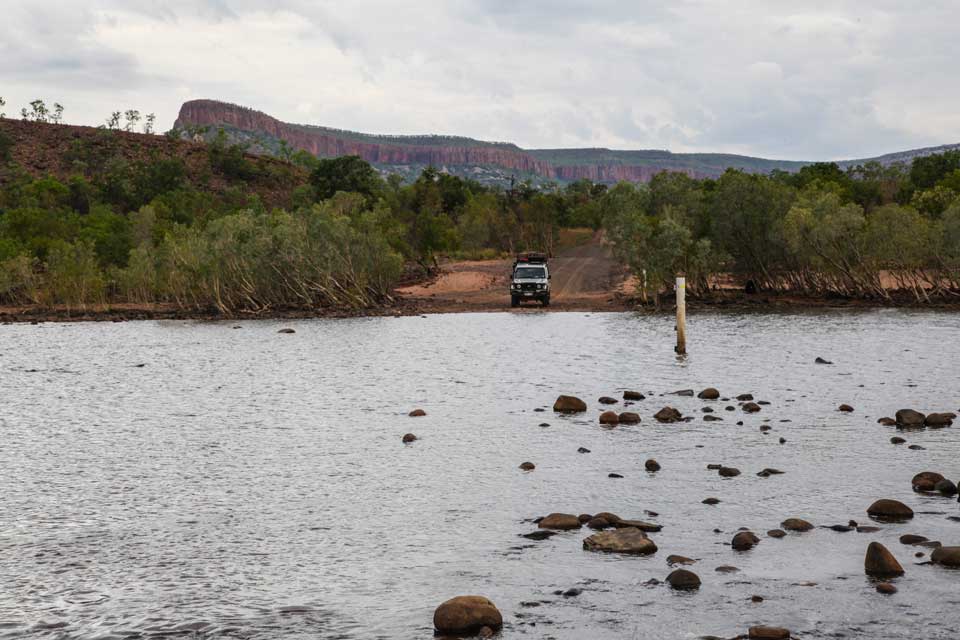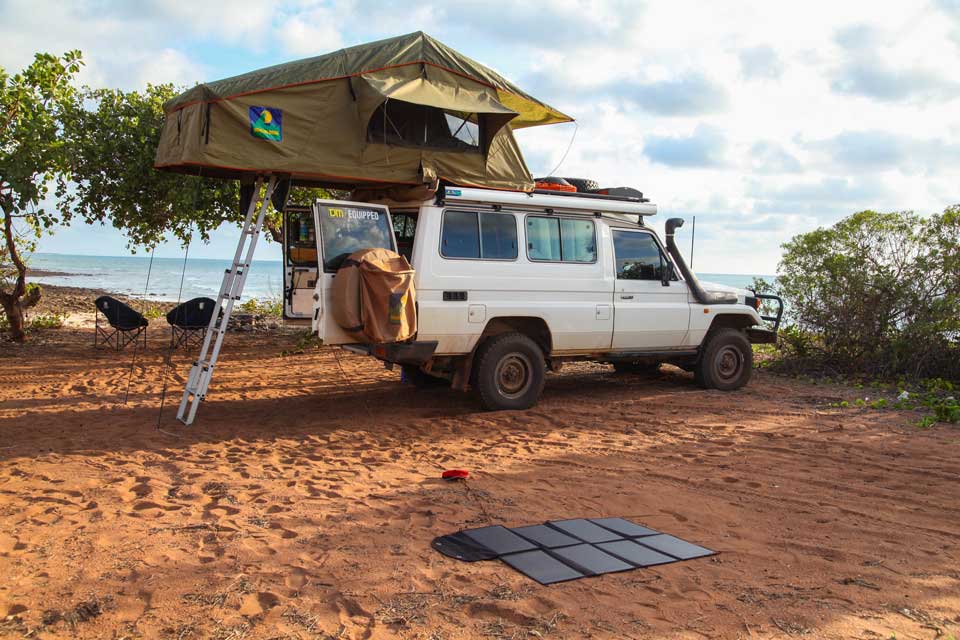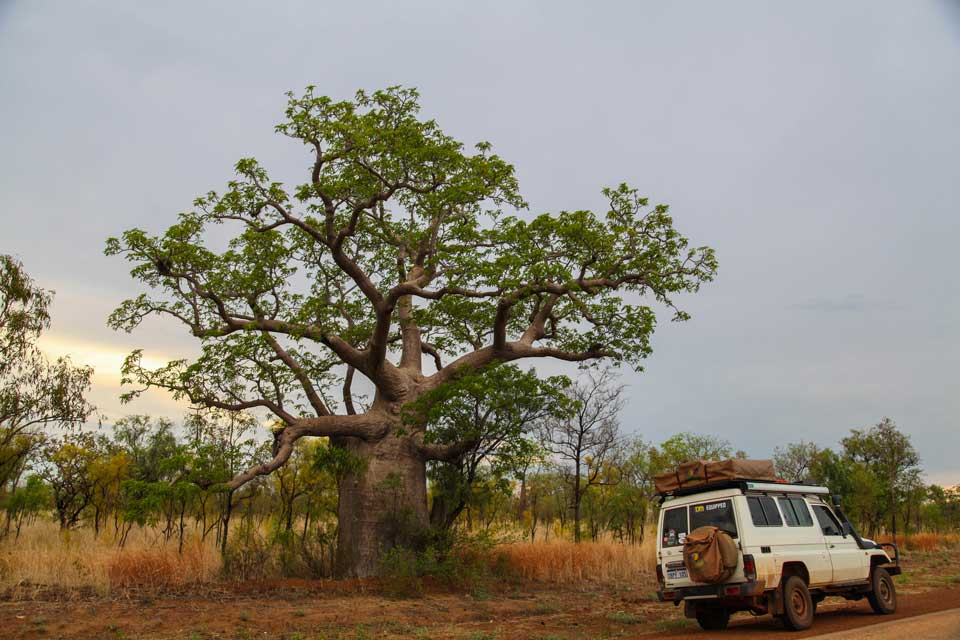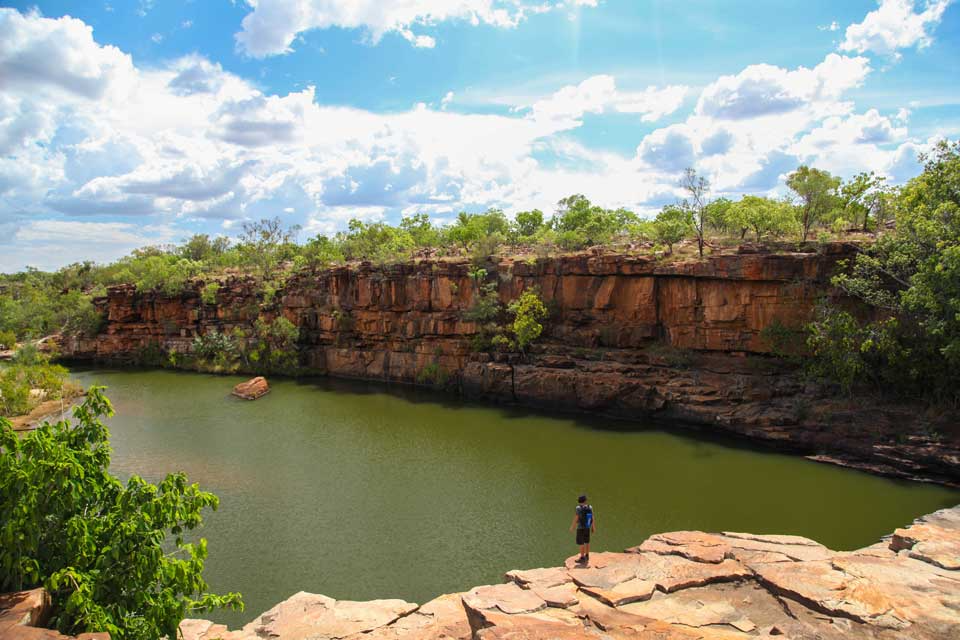The Last Car Through the Gibb River Road
Words and images courtesy of Rinus Hartsuijker, a Dutch explorer currently travelling around Australia.
The clouds are hanging like smoke plumes in a clear blue sky. You would almost have to squeeze your eyes shut to look into the sun and see them. They could have been smoke signals from some Indian tribe by the round and identical look of them. Without any warning the clouds start to form a thick blanket, which turns a dark grey and bursts open just a few minutes later. Water flows in long red-coloured streams and finds its way through the soil. We’re driving an unsealed road, the red mud gets stuck in our tires and all four of them spray the wet red dirt around as we drive.
We have started on the legendary Gibb River Road, once a road to move cattle, but now a 4WD track that every offroad enthusiast wants to drive. As Lonely Planet describes: “ A high-clearance 4WD (e.g. Toyota LandCruiser) is mandatory, with two spare tyres, tools, emergency water and several days’ food in case of breakdown.” I believe we have this sorted.
Gibb River Road Navigation & Maps
Hema HX-1 Navigator
The largely unsealed road of about 660 km long lies between Kununurra and Derby and along it are some of the most stunning gorges to be found in Australia. We really want to experience this drive, but time is running short and it is already December. The wet season is about to commence and this road can be closed at any time when the circumstances are unsafe for travel.
 Fortunately, the department of Transport in Kununurra informed us it would still be safe, but that we should not take longer than 4 days and that we would probably be one of the last cars to drive the whole thing from there to Derby before they close it off.
Fortunately, the department of Transport in Kununurra informed us it would still be safe, but that we should not take longer than 4 days and that we would probably be one of the last cars to drive the whole thing from there to Derby before they close it off.
The rain stops as suddenly as it started. The clouds drift away like sailboats and leave an empty blue ocean. I turn down my window and warm, humid air flows in. The road takes us up an elevated plateau with an impressive grey rock wall which beautifully contrasts with the red dirt and blue sky. I see two vehicles coming from the way we are heading. They seem to be sand coloured from a distance, but when they pass us they turn out to be the same white Landcruiser Troopcarrier that we are driving, camouflaged by a layer of mud. We now know what awaits us…
We don’t have to wait long for that matter, before we know it we’re standing before the Pentecost River: a 300 meter long river crossing. Helga gets out her trekking poles, puts the camera in a water resistant backpack, grabs an Oricom handheld from the glove department and starts to walk across the river. The Troopcarrier waits with its front wheels in the water and me on the bonnet scouting the river. We realise that this river probably has some less dangerous freshwater crocodiles, but could also house some bloodthirsty saltwater ones since the river ends in the sea.
The water almost reaches her shorts, but it doesn’t seem to bother her. She won’t be distracted by the current and reaches the other side quickly. I now know what depth to expect. Over the radio Helga tells me about the obstacles and the route to take.
Slowly, in low gear, I follow her trail with our loaded Troopy. When we’re on the other side the clouds, again, turn to a solid grey blanket. By the time we are both safe and sound inside the car the blanket tears open: just in time.
The road winds through a breathtaking landscape. The road is rough, but the low tyre pressure makes it bearable. We stop to have lunch at Rollies Jump Up, make coffee with our percolator and look out over a long stretch of nothing. The whole day we are the only ones on the road.
 We set up camp at Kennedy Creek next to an old fire pit. For many years travellers through the Kimberleys have stayed here and probably not much has changed. We have already left before the sun rises. It must have rained extensively a few kilometres down the road because it’s alternately mud and sand. We take a turn off the Gibb towards “Gibb River” cattle station. A young couple opened a little shop here about a year ago and together with the Aboriginal community, a nurse and the owner of the station they form a small, but hospitable place to stay. Three large mango trees are the centre of attention when we pull up and leave us and the car in some more than welcome shade. We enjoy the stories from the people we meet and we feel very welcome in this community. The map comes out quickly and we leave with several notes and circles around places not to miss along our way. We return to the main road full of new ideas and places to visit.
We set up camp at Kennedy Creek next to an old fire pit. For many years travellers through the Kimberleys have stayed here and probably not much has changed. We have already left before the sun rises. It must have rained extensively a few kilometres down the road because it’s alternately mud and sand. We take a turn off the Gibb towards “Gibb River” cattle station. A young couple opened a little shop here about a year ago and together with the Aboriginal community, a nurse and the owner of the station they form a small, but hospitable place to stay. Three large mango trees are the centre of attention when we pull up and leave us and the car in some more than welcome shade. We enjoy the stories from the people we meet and we feel very welcome in this community. The map comes out quickly and we leave with several notes and circles around places not to miss along our way. We return to the main road full of new ideas and places to visit.
Thirty-one kilometres later we leave the Gibb again. We start on the road that will lead us towards Mount Elizabeth Station and for the next 29 kilometres, which is not that long save for the teeth shattering corrugations, we mindlessly endure the rough road. When we reach the homestead we find out that the owner has left the station for the wet season and we meet the caretakers. They turn out to be both writers and they decided to live in this desolate place to finish their books. Surprised by us visitors so late in the season they don’t hesitate to answer our enquiries. The owner from the shop we just visited made some notes on how we should visit the Wunnumurra gorge that belongs to Mt Elizabeth Station. There should also be some Aboriginal art around on the rocks a little bit further downstream. The writers have no knowledge about the art, but give us the small laminated mud map of the area which shows us the way to the gorge and point out the grey gate towards the beginning of the track.
We cross a small river and slowly start on the narrow road that winds through the dense vegetation and boulders. It is obvious that this road has not been used for a while now. Nature has started to reclaim some parts of it; we can hear the low scrub in the middle of the track brushing underneath the car, roots found their way over the road and the first rainstorms left deep ditches to navigate around.

We stop when we reach a steep and rocky descent we don’t want to risk with our car. The sun is at its highest point, but we decide to follow the rest of the track on foot. We battle the heat step by step, while our footprints are clearly visible in the dust behind us. The track becomes more narrow until all that remains is a walking trail on which we continue. Small white ribbons are the only way of knowing we are actually going the right way. From beneath her pink cap I can see Helga’s face; sweat trickles down her face into her t-shirt and her colour matches that of the cap.
A water python watches us from its hiding place when we make our descent into the gorge. We waste no time, undressing to quickly dip in the cool, blue-green water.
A little while later I am in search of the rock art along the edges of the Wunnumurra gorge. The trail is almost not a trail anymore and it’s hot - almost unbearably hot. I had just dried from the dip in the pool, but it seems as if that was hours ago instead of minutes. I give up. The little drawn map is just not detailed enough. Half an hour later and we’re back in the car. Two hours later and we’re taking a turn onto Gibb River Road. To be able to drive 80km/h again is an absolute joy by now. We spend the night at Galvans Gorge and are disappointed when it turns out to be just a small pool with no flowing water the next day. We decide to skip our morning swim and drive on to “Over The Range” Car and Tyre Shop.


Neville Hermon settled here about 14 years ago coming from New South Wales. He saw a business opportunity and fell in love with the Kimberleys. Slowly he managed to build up his shop and when we look around us there are a lot of cars that did not make it until the end of the Gibb. Neville mainly uses LandCruisers and we make out a 40, a 60 and a 70 series around the main building. He now employs one man and he tells us that his next focus is to build a house for his family so they don’t have to live in a caravan anymore.
Neville points out that we should go to Adcock Gorge a little bit further down the road and we take a belated morning swim there. After this we drive through King Leopold Ranges, past Queen Victoria’s head and put up the tent near Kimberley Downs just before the rain hits again. We watch the road turn into a muddy affair and I look at Helga: we both start to laugh, again, we are just in time. When we drive the last stretch of the Gibb River road we are becoming more and more aware of the trees along side the road. The Boab Trees are not to be missed in this part of Australia. These ancient trees are amongst the longest living things in the world and some are more than 2,000 years old. Storing water from spring rains give them their swelled trunks and distinctive look. We pass more and more cars and we realise the past days of seeing maybe one car a day are over. Civilisation is around the corner and as the gravel turns into bitumen the quietness of the car lets us relive the wonders of the Gibb River Road in our minds.









0 comments